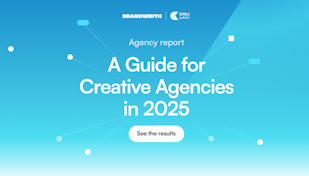Today’s (in-house) agency challenges and how to tackle them.

Since the dawn of marketing time, agencies have been considered the go-to resource for in-depth brand knowledge. Clients, both internal and external, have looked to agencies not only for creative ideas, but mainly for brand governance and continuity. In turn, this is how agencies have positioned themselves and how they demonstrate value for their customers. And yet, agencies ought to evolve towards a more strategic role.
Today's agencies have become factories
The default reliance on agencies to provide services can become challenging. Design is often considered a commodity, available at all times without limitation. In-house agencies, especially, are often abused by departments wanting "free service". Not to mention that not all projects are equal. Some have questionable impact or value, but still consume a lot of bandwidth.
According to the 2019 In-house Creative Report by Boss and Cella, the top four activities for an internal agency (both traditional and digital-specific) are graphic design, production design, digital design and ad banners. Is it just me, or does that sound more like a factory than an innovation lab?
The Productivity Paradox
64% of the teams interviewed adopted methodologies like agile to increase productivity. But even with these methodologies in place and despite investments in project management software, agencies just continue to crank out deliverables, and still lack the required time to sharpen the axe.
If I had six hours to chop down a tree, I'd spend the first four hours sharpening the axe
Abraham Lincoln
CHILI publish
Projects are almost always more iterative than expected, and 63% of creative leaders stated that multiple revisions and insufficient time are their greatest challenges; both are most often the result of client behavior.
When asked, the majority of creative leaders said only 20% of their agency's time was spent on high-value creative conceptual work, and design adaptation and pure production work took up 60% of the agency's time. This is the productivity paradox: agencies are so busy doing production work, there is hardly any time left for projects that matter.
The pressure of new deliverables
At the same time, agency teams are increasingly expected to build new types of deliverables. For example, there is a growing demand for them to produce video. Over 70% of the teams already provide video production services, and this percentage is only expected to grow. Video can be very labor-intensive and requires specialized training. (The difficulty of planning this training is another source of frustration for teams and their leadership.)
Video is set to grow explosively soon and places significant demands on bandwidth and resources, in addition to the ongoing demands of graphic production work.
Out of sight, out of control.
Global teams have additional challenges. Connecting with colleagues to clarify and provide guidance can be frustrating, especially when time zones have limited or nonexistent overlaps. Under these conditions, local teams may begin running their own show in parallel and beyond the control of the brand.
The hills are high and the emperor is far - Chinese proverb
This is not malicious, mind you. It is just the most practical thing to do to make things move forward. Remote teams often have to rely on slow shared networks, and there is no quick fix for this. 70% of the teams use internal infrastructure to share files over the intranet or servers, but 48% of teams do not use a digital asset management system. A whopping 52% use email to share files between locations. You have read that right. Email.
In addition to the woes of sharing files; communicating project details and providing creative direction also prove to be difficult. Project hand-offs don't happen efficiently across locations. Only 32% of the teams use a dedicated soft-proofing software to collect and track feedback.
Even if teams are not global, it is unlikely all staff is in one central location. The US alone has 8 million people or 5.2% of the workforce working from home (US census Sept 17., 2018). Remote working makes sense for employers: home-based employees tend to be more productive, have fewer unscheduled absences, and real estate costs for the company decrease.
How can teams evolve?
So even if there is a clear vision for an (internal) agency to evolve to a more strategic role, today's workload will not magically evaporate into thin air. Agencies still have to deliver at scale, and clients both internal and external will expect more numerous and more diverse deliverables.
Hiring seems -budget permitting- a viable solution. Available talent, however, is scarce. Only 7% of internal agency leaders believe there is an abundance of talent, down 20% since 2018. Often, specialized graphic designers and developers are harder to find than expected.
After successfully hiring staff, the number one challenge for many agencies is lack of experience, and training is critical to get new hires up to speed quickly. The productivity paradox is pervasive, though: 71% of in-house creative agency leaders state they either don't have enough time, or they have no time at all to provide their team with coaching and development. Remote employees are even more difficult to onboard and train.
Perhaps partnering with other (external) agencies is a way forward. After all, 78% of teams do it. Partnering is mainly done to get access to extra capacity, but also to be able to run special projects and get access to new ideas and specialized skill sets. But external agencies come at a cost, and you will be paying top-dollar for work that could be automated with the right technology.
How should your technology evolve?
The increased complexity, the appetite for new types of deliverables, and the incessant demand for more assets to be produced, are very specific challenges any agency must face, whether in-house or independent.
Agencies that have a good chance of success under these new and rapidly evolving conditions are aware they need to evolve to a more strategic approach.
This means
- Providing good brand governance at scale
- Getting comfortable building more diverse assets for a multitude of channels
- Managing the problems related to remote teams and team members
- Hiring, training and coaching staff efficiently
But if an agency is to be truly successful at delivering at scale, it will have to break the productivity paradox. Instead of burning up valuable bandwidth for repetitive production tasks, it will need a bias to quick delivery of final files, while limiting the production drudge.
It looks like the productivity paradox's days are numbered, though. We have seen a few interesting examples of agencies adopting technology to simplify and automate their design production work. By converting graphic documents into smart templates, they were able to cut production time dramatically, reduce the number of review cycles to a minimum, and enable self-service, so clients -internal and external- could build the graphic assets themselves. They successfully solved the problem of menial production work eating up valuable bandwidth with the right technology choices.
Sources:
2019 In-house Creative Report by Boss and Cella
2018 US Census
Marketing
Piet Saegeman
Sep 6, 2019


